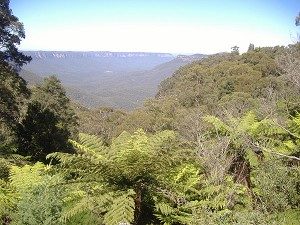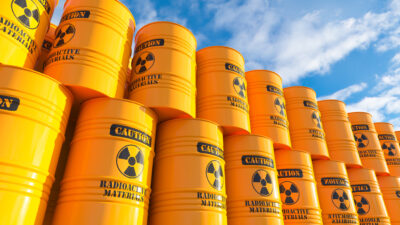
Blue Mountains

Sydney, Australia, is inarguably one of the most beautiful cities in the world, but even the excitement of a sophisticated seaside metropolis can begin to wane when what many of us are seeking for our precious holiday time is the simple pleasures of peace, quiet and natural beauty.
Travelers destined for Australia are now heading out on an ever more frequent basis to the Blue Mountains, located just 90 minutes by car from the hustle and bustle of Sydney.
World Heritage List Wilderness
More hills than mountains, the Greater Blue Mountains were nonetheless deservedly listed as a World Heritage Area by UNESCO in 2000. Encompassing eight national parks and covering more than one million hectares, much of the area is a sandstone plateau with a dense canopy of eucalyptus forest. It is a stunning landscape that conjures visions of a time that existed long before endless meetings and personal digital assistants.
Marked by a distinct bluish color, the haze that lingers over this wilderness area is actually vapor created by the millions of eucalyptus trees that flourish here. With air that is pregnant with moisture (that some claim has restorative properties) the Blue Mountains could best be described as Australia’s lungs.
To find out more about this unique biosphere, I joined Tim Tranter, a local guide who for 27 years worked as a firefighter and now runs a tour company called Tread Lightly. They specialize in educating visitors about the many attributes of the Blue Mountains region.
„This is the largest wilderness playground next to Sydney,“ says Tranter, pointing to the hills that extend out to the horizon as far as the naked eye can see.
A site for coal mining activity in the late 1800s, the main industry in the Blue Mountains today is tourism. This is fueled by a growing number of appreciative visitors who are interested in journeying to parts of the world where vast tracts of rainforest, such as exist here, are unfortunately becoming increasingly rare.
In addition to more than 100 species of eucalyptus, the Blue Mountains are home to a diverse range of wildlife, including the copperhead snake described by Tranter as „the eleventh most venomous snake in the world.“
Occasionally pressed into service to relocate snakes from backyard pools in the nearby town of Katoomba, this professional guide dismisses any lingering fears that danger lurks on the forest floor.
„There are 2,000 to 3,000 snake bites every year in Australia,“ he says. „And most of the bites are because people are trying to kill the snakes.“
With that pointed piece of wisdom and a pledge to leave all snakes I encountered unharmed, we boarded a Swiss-engineered Scenic Cableway tram that descends 1788 metres to the floor of the Jamison Valley. What awaits is a subtle 1.5-mile boardwalk that allows visitors to trek through a place that famed scientist Charles Darwin once described as „striking, magnificent and profound.“
A Trip Back in Time
 MISTY MOUNTAINS: A blue haze hovers over the Blue Mountain area, a by-product of the lush eucalyptus growing there. (Wes LaFortune)
MISTY MOUNTAINS: A blue haze hovers over the Blue Mountain area, a by-product of the lush eucalyptus growing there. (Wes LaFortune)
 MISTY MOUNTAINS: A blue haze hovers over the Blue Mountain area, a by-product of the lush eucalyptus growing there. (Wes LaFortune)
MISTY MOUNTAINS: A blue haze hovers over the Blue Mountain area, a by-product of the lush eucalyptus growing there. (Wes LaFortune)
„This is pure wilderness,“ says Tranter. „This is why we come down here—the pure isolation.“
Feeling much more relaxed at the bottom of the valley floor than back on top where tourists continued to mingle, I began to understand why Tranter is so passionate about protecting this magnificent place.
„It feels like you’re walking back in time,“ he says.
Left over from another epoch on the evolutionary continuum, the Blue Mountains region is one of the only places on this mostly arid continent that retains a connection to a time when all of the southern hemisphere’s landmasses were connected, creating what is often referred to as Gondwana. Punctuating this point is the Wollemi pine, one of the world’s rarest trees. Thought to be extinct, they were re-discovered in 1994 by a hiker in the Blue Mountains. The Wollemi pine, believed to have existed in the time of dinosaurs, today continues to grow in two different stands in the now-named Wollemi National Park (part of the Greater Blue Mountains Area).
After spending more than two hours walking through this „laboratory of ecological and biological systems,“ and without any run-ins with snakes, I too share my guide’s reluctance to return to the tram and make the ascent back to the „real world.“
A short drive from Australia’s largest city, the Greater Blue Mountains World Heritage Area is a destination that not only allows visitors to escape the daily grind but also literally disappear into another time.
(The Epoch Times)





























vielen Dank, dass Sie unseren Kommentar-Bereich nutzen.
Bitte verzichten Sie auf Unterstellungen, Schimpfworte, aggressive Formulierungen und Werbe-Links. Solche Kommentare werden wir nicht veröffentlichen. Dies umfasst ebenso abschweifende Kommentare, die keinen konkreten Bezug zum jeweiligen Artikel haben. Viele Kommentare waren bisher schon anregend und auf die Themen bezogen. Wir bitten Sie um eine Qualität, die den Artikeln entspricht, so haben wir alle etwas davon.
Da wir die Verantwortung für jeden veröffentlichten Kommentar tragen, geben wir Kommentare erst nach einer Prüfung frei. Je nach Aufkommen kann es deswegen zu zeitlichen Verzögerungen kommen.
Ihre Epoch Times - Redaktion